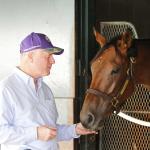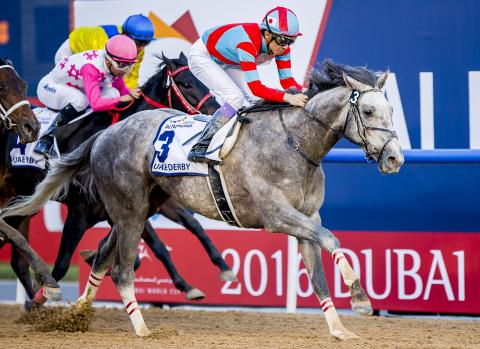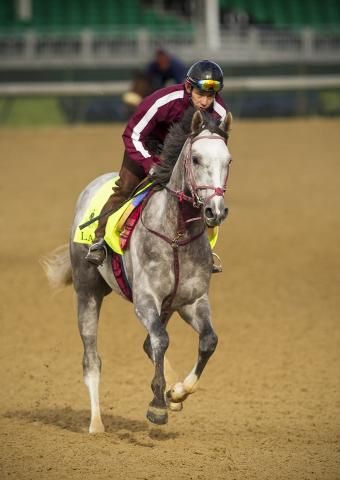
Cugino Gets Slight Edge in Wide-Open Ft. Lauderdale Stakes

“The Japanese horse” they all called him, though he was born right here in the United States. Kentucky, even. A son of Tapit, our country’s top sire, which makes him related to many of the top American horses – including Creator, another gray horse in the Belmont Stakes. His maternal grandsire is Sunday Silence, the 1989 U.S. Horse of the Year. Lani spent most of his yearling year in the United States being broken and pre-trained before his owner, Koji Maeda, had him shipped to Japan to be trained for racing there. He had spent a pretty penny breeding Lani, and his intentions were to make Lani into a Japanese champion, under the tutelage of trainer Mikio Matsunaga.

“Looney Lani” they all called him, though he was no more or less looney than many champions that had come before him. The press and the onlookers from one American racetrack to the next liked to make fun of him. “Head case,” “weird,” “crazy,” or even “wacko” were all used to describe Lani and his behavior in training. It wasn’t all without merit. Like many adolescents, Lani was a moody horse. What set him apart was how little he tried to repress his own id. If he felt it, he did it. If he didn’t feel like it, he didn’t do it. If you tried to get him to do something other than what he had decided, he fought you. But mainly he just tried to fight the other horses.
“He’s happy when he’s racing and with the people he’s OK,” Matsunaga explained. “But when he sees the other horses he’s very aggressive and can have a strong mind.” In Kentucky he would fight and kick and howl almost every time he left his stall. He had three workouts before the Derby and he fought his rider in all three. He refused to go into the gate to be schooled. He kicked and dug into the dirt. Whenever he’d see a filly, he’d get excited and “act studdish”- his necessary equipment standing at attention. Whenever he’d get close to another colt, he’d try to pick a fight. In the paddock before the Derby he kicked the walls.
By the time Lani got to Pimlico for the Preakness, Matsunaga had a plan for many of Lani’s various quirks. They kept his stall doors completely shut so he wouldn’t see other horses. They wouldn’t saddle him in the paddock alongside of everyone else. They’d skip the customary post parade (as they had in Louisville) and take Lani around to the backstretch to walk and calm down all by himself. “I know all horses should attend the post parade. Because of his characteristics, it is very hard,” Matsuanga said. “He has a great chance to give trouble to the other horses, which I never want.”
Essentially they kept Lani away from other horses as much as they could, and let him take long naps during the day. Despite trying to kick the starters as they tried to load him into the starting gate for the Preakness, Lani still ran a better race than he had in Kentucky. But it wasn’t good enough, he still didn’t hit the board.
Never the matter, Matsunaga and Maeda had always intended the Belmont Stakes as their prize. The track at Belmont, wide and sandy, was more like the tracks Lani was used to in Japan. And the added distance should help the horse. While he may not have been as fast as Nyquist or Exaggerator, he was conditioned as good or better as any North American horse. Yet another “looney” thing that Lani’s Japanese connections were teased about: he spent forever on the track each morning training. While most other horses might do a couple of miles around the track, Lani would do six. While American trainers feared exhausting their horses with too much exercise leading up to a big race, Lani’s trainer put him through long, slow workouts every single day. He believed it made Lani better conditioned to come back and pass tiring horses in the famous Belmont stretch.

Tagg was probably not exaggerating. Shug McGaughey was allowed to saddle Coronado’s Quest away from the other horses and skip the post parades at Belmont when he came here in 1998 after being sidelined from Triple Crown contention because of similar bad behavior: throwing riders and chomping at other horses. They called him the “bad boy of Belmont,” too. When War Emblem came here to try for the Triple Crown in 2001, the press were all aghast at the horse’s bizarre behavior. For one thing, War Emblem liked to bite. He’d bite other horses, people, or just random objects that crossed his path. He’d eat the food of his rivals in the stables right in front of them. He’d refuse to be led in hand and would walk ahead of his trainer, barreling people out of his way. Bob Baffert, War Emblem’s trainer, nicknamed the horse “Hannibal Lecter.” That horse ended up in Japan after stumbling in the Bemont and just missing the Triple Crown. Another cantankerous horse, Sunday Silence, nearly killed his trainer Charlie Whittingham with a kick to head while being led through the tunnel before the Belmont Stakes. Come to think of it, that horse ended up in Japan, too. And in more ways than one, that horse begot Lani.
“The sleeper pick,” they all called him, at least on the morning of the Belmont Stakes as the early assembled horseplayers readied their lawn chairs and ice chests and compared notes for the day’s card. One person after another touted me on Lani. “This is what he came here for,” they’d say. “He can get the distance,” they’d say. “Don’t be fooled by all of his antics, he looks great,” they assured me. Lani had presented himself well at Belmont in training for the big race. Many people were talking about how good he looked on the track. But the Belmont had a big, stacked field. If Lani wanted to go back to Japan with the trophy, he had a lot of work to do.
But Lani was putting in the work. Training well and behaving better for his handlers. Sure, he still got too excited whenever he passed a filly or too aggressive when he passed a colt. He hadn’t adjusted so well to the community of horses in the Belmont backstretch. But he was responding better to the people – his trainer and riders especially. He was schooling in the gate and working out like he was back home in Japan again. His exercise rider, Eishu Maaruchi, also from Japan, believed that Lani was poised to show the world what he could do. “When we have the same opinion, the rider wants to run and the horse wants to run, he can run very fast.” “If he won it,” Matsunaga said, “for me it would be no surprise.”
They skipped the post parade and the crowd singing along with Frank Sinatra and took Lani back to the far reaches of the backstretch, along a wall at the top of the final turn. While the other horses did the customary walk before the assembled 60,000 fans, Lani stood patiently far away, waiting for his turn to show how fast he could go. The NBC telecast showed him standing there looking off into the far distance at his competition, perhaps forlornly. They chuckled at the weird one.
When the gate finally opened, Lani got a clean break, but still settled in the back of the pack. There he raced for much of the first half mile, settled back over a dozen lengths from the leader. But after a half mile he made his first move, picking up some pieces and joining Exaggerator on the outside of the leaders, just off the favorite’s hip. Lani would take the final turn wide, and in the homestretch would give it all he had. He bounded forward, running past the Preakness winner who had nothing left, passing one tired horse after another. Rider and horse in full agreement, Lani would run faster than all of them, save for two, Destin and Creator, who would hit the wire ahead of Lani in a photo finish.
2016 Belmont Stakes
Moments after the race began the rain that everyone had feared all day long finally began. The first drops hit the crowd as Lani passed by on the first approach. By the time he crossed the finish line the rain was coming down in a steady pour. Lani’s connections stood in the tunnel, unsure of what to do next. They were unhappy. They clearly expected to win. And though Lani’s finish was much improved over his last two Triple Crown starts, and though he had nobly finished all three legs of the Triple Crown, improving each time, and though he had earned a share of the $1.5-million purse, the Japanese contingent seemed displeased, standing there in the rain in the moments after the race. As Creator’s connections received their trophy under a torrential downpour of rain, Lani walked back to the barn where he was walked in a circle to cool himself down.
By the time the next race had started, the rain had stopped and a rainbow stretched over Belmont Park. Lani’s owner announced that after the horse’s mandatory quarantine, they’d be heading back home to Japan. Lani would never race for American fans again. But Matsunaga vows he will be back to test Japanese-trained horses in the Triple Crown races again. “But with a different type horse,” he said. “I would want one that is tough, very capable, and possibly a front runner ... and easier to handle.”